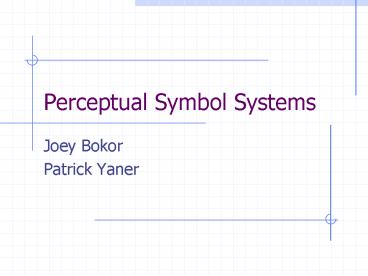Perceptual Symbol Systems - PowerPoint PPT Presentation
1 / 18
Title:
Perceptual Symbol Systems
Description:
Perceptual Symbol Systems. Joey Bokor. Patrick Yaner. 3/14/2003. Perceptual Symbol Systems ... A common representational system underlies perception and cognition ... – PowerPoint PPT presentation
Number of Views:290
Avg rating:3.0/5.0
Title: Perceptual Symbol Systems
1
Perceptual Symbol Systems
- Joey Bokor
- Patrick Yaner
2
Grounding Cognition in Perception
- Claim Cognition is inherently perceptual
- A common representational system underlies
perception and cognition - From Aristotle to Locke to Kant, theorists over
the last 2000 years have viewed cognition as
imagistic in nature
3
Grounding Cognition in Perception
- Image-based theories disappeared as behaviorists
and language philosophers began to shy away from
mental states - Recently, cognitive scientists have been working
with representational schemes that are inherently
nonperceptual, or amodal
4
Problems with amodal systems
- Little direct empirical evidence that amodal
systems exist - Failure to provide a satisfactory account of the
transduction process that maps perceptual states
into amodal symbols - Also the converse, the symbol grounding problem
- Too powerful able to explain any finding
post-hoc, but often without much illumination
5
Perceptual States
- Arise in sensory-motor systems
- Two components
- Unconscious neural representation of physical
input - Optional conscious experience
6
Perceptual Symbols
- The structure of a perceptual symbol corresponds
(at least somewhat) to the perceptual state that
produced it - Note this does not claim that a perceptual
symbol corresponds to the physical world
7
Perceptual Symbols Are Not
- Like physical pictures
- Mental images
- Any other form of conscious subjective experience
- The record of the entire brain state that
underlies a perception
8
Perceptual Symbols Are
- Partial records of the neural states that
underlie perception - Dynamic, not discrete
- Not necessarily representative of specific
individuals - Potentially indeterminate
9
Systems of Perceptual Symbols
- Related perceptual symbols combine to form
simulators that allow the cognitive system to
construct specific simulations of an entity or
event in its absence
10
Simulators
- Composed of frames and the simulations that the
frame produces - The figure shows a partial frame for car and
illustrates how the frame changes dynamically
11
Simulations
- Simulations are always partial and sketchy, never
complete - Simulations are likely to be biased and distorted
in various ways, rarely, if ever veridical - A simulator goes beyond a simple empirical
collection of sense impressions. It is both
rational and empirical, reflecting intertwined
genetic and experiential histories.
12
Simulators
- Two levels of structure
- A deep set of generating mechanisms (typically
unconscious) - These produce an infinite set of surface images
(typically conscious)
13
Concepts and Simulators
- A concept is equivalent to a simulator
- If we have an appropriate simulator of something,
then it can be said that we understand the
concept - Thus the primary goal of human learning is to
establish simulators
14
Summary
- Perceptual states arise in the sensory-motor
system - A subset of the state is extracted by selective
attention and stored in long-term memory - This perceptual memory can function as a symbol
entering into symbol manipulation - Collections of the perceptual symbols comprise
our conceptual representations
15
Problems with PSS
- Adams Campbell
- Three criticisms
- Significantly incomplete description of a
simulator - No demonstration that the activated neural
connections are constitutive of the relevant
concepts. Empirical evidence suggests activation
while thinking of a concept, however what proof
is there that the activations that form a
Perceptual Symbol and are not simply a byproduct
of thinking - Failure to account for abstraction truth, anger
etc.
16
Problems with PSS
- Brewer
- the ontological status of perceptual symbols is
unclear and this form of representation doesnt
account for all forms of human knowledge - abstract constructs such as entropy, democracy
and abstract - (non model) scientific theories such as evolution
and quantum mechanics - gist recall in abstract schemes
- logical words such as but, therefore and because
- language form
- the underlying argument structure of his own
article
17
Problems with PSS
- Dennet Viger
- Sort-of Symbols
- What kind of things are thoughts, and how do you
make em out of brainstuff? - Similarly what does it mean to think in
perceptual symbols - Paper provides the specs but not yet a model for
PSS
18
References
- Barsalou, L. W. (1999). Perceptual Symbol
Systems. Behavioral and Brain Sciences 22
507-569. - Barsalou, L. W. (1999). Perceptions of
Perceptual Symbols. Authors response to Open
Peer Commentary, in Behavioral and Brain Sciences
22 637-660. - Adams, Fred and Campbell, Kenneth (1999).
Modality and abstract concepts. Commentary on
L.W. Barsalou, Perceptual Symbol Systems in
Behavioral and Brain Sciences 22 610. - Brewer, William F. (1999). Perceptual symbols
The power and limitations of a theory of dynamic
imagery and structured frames. Commentary on
L.W. Barsalou, Perceptual Symbol Systems in
Behavioral and Brain Sciences 22 611-612. - Dennet, Daniel C. and Viger, Christopher D.
Sort-of Symbols? Commentary on L.W. Barsalou,
Perceptual Symbol Systems in Behavioral and Brain
Sciences 22 613.

